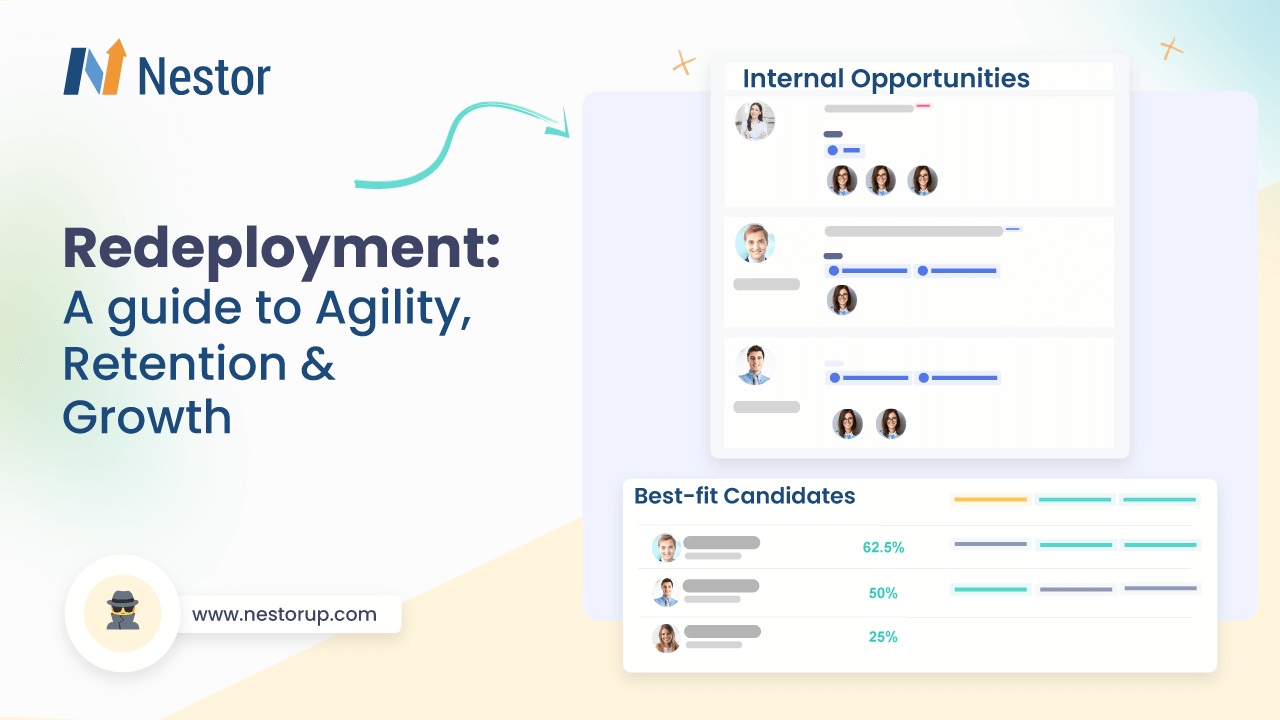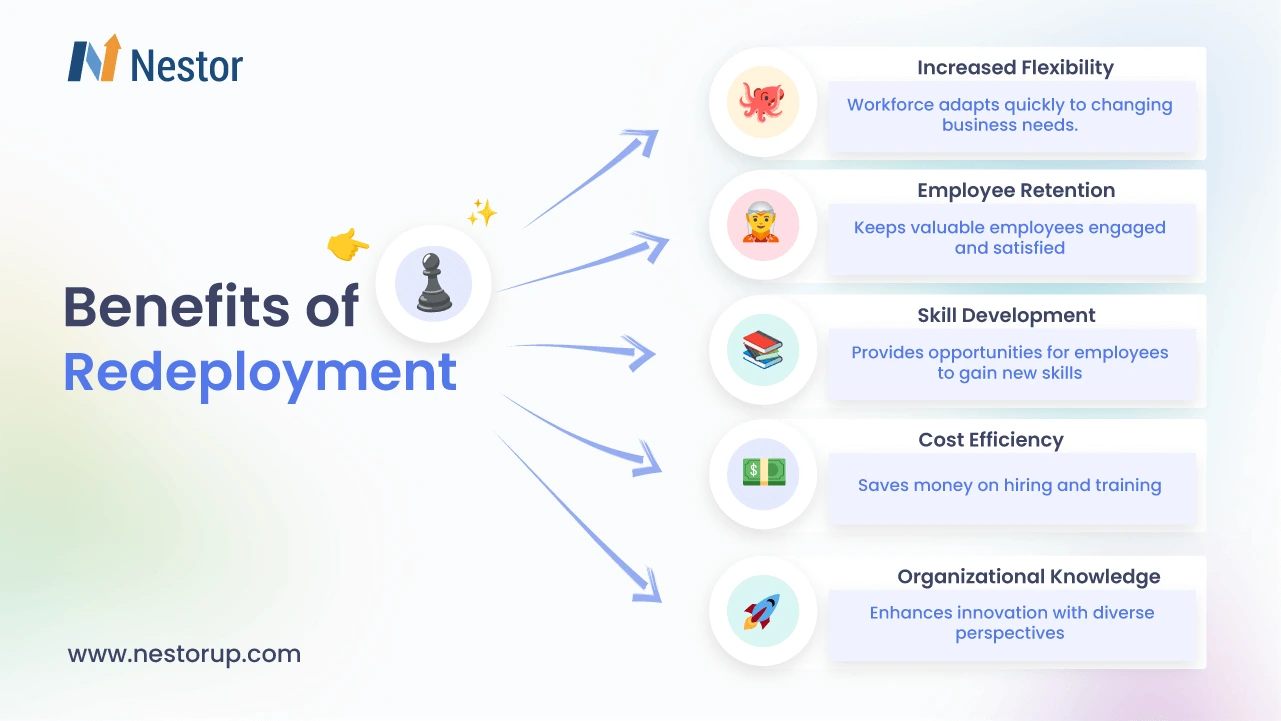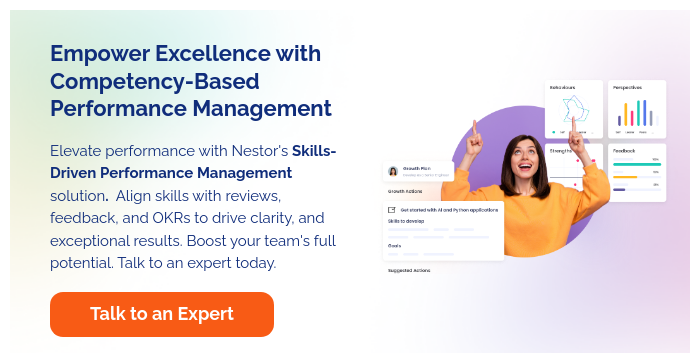
Contents
In business, change is inevitable. Companies must evolve with market shifts, technological advancements, and new economic realities. But what happens when those changes require a company to rethink how it manages its workforce? Rather than resorting to layoffs or hiring from outside, many organizations are finding success with an alternative: redeployment.
So why does redeployment matter? What makes it such a valuable tool in workforce management, and how can it be executed effectively?
While some may see it as a quick fix to avoid the costs and disruptions of hiring, redeployment offers much more. When done correctly, it boosts employee retention, strengthens skills, and drives overall organizational agility. It also directly addresses a major challenge facing businesses today: career opportunities—or the lack thereof.
Ready to explore the ins and outs of redeployment? Let’s dive right in!
What is Redeployment?
At its core, redeployment refers to the internal reassignment of employees to different roles or departments within the same company. This process is also known as talent redeployment or workforce redeployment. Unlike layoffs or downsizing, the goal of redeployment is to retain talent by moving workers to areas where they can add the most value. This is especially important during times of restructuring or change.
People are typically redeployed to a different role through lateral moves, but sometimes it can also be to another location or branch, within a reasonable commute distance.
This strategy is becoming increasingly relevant in today’s job market. According to Gartner, 56% of candidates report applying for jobs outside their current area of expertise. This willingness to cross traditional boundaries indicates that employees are eager to learn new skills. They want to take on diverse roles. Redeployment can offer these opportunities within your organization.
Also, this approach benefits both businesses and employees. It helps companies retain talent, cut hiring costs, and preserve knowledge. Redeployment offers new career opportunities for employees. It promotes skill growth and enhances job security. This approach encourages internal mobility and keeps the workforce engaged.
In essence, redeployment is a proactive workforce strategy. It matches talent to evolving business needs. This creates a win-win scenario for both the organization and its people.
What are the benefits of redeployment?
Now that we know what redeployment is, let’s talk about why it’s worth the effort. Here’s a breakdown of the key benefits:

Increased Flexibility
One of the primary advantages of redeployment is the flexibility it offers organizations. For example, your company has been focusing on developing a new software product. As a result, there’s a surge in demand for customer support.
Instead of hiring and training new staff, you can redeploy some developers with strong communication skills to support the team temporarily. This quick adjustment allows you to meet customer needs without missing a beat.
Employee Retention
Hiring externally may bring new ideas, but it’s also expensive, time-consuming, and often unnecessary. Moreover, redeployment can reignite an employee’s passion for their work. Workers often feel stuck or stagnating in their current roles. A fresh opportunity can restore their enthusiasm and engagement.
With 75% of employees looking at positions in other companies, redeployment can be used as a retention tool. Why? Because it offers the career growth opportunities that employees crave, potentially reducing turnover. How? Through redeployment, businesses can create new challenges and career paths rather than risking the loss of experienced staff to competitors.
Knowledge Retention and Distribution
Long-time employees know a lot about how the company works. When they move to new roles, they bring that knowledge with them. This can help different parts of the company work better together.
Imagine a manufacturing firm that needs to scale back operations in one area but wants to launch a new product line in another. Instead of laying off experienced workers, the company can redeploy them to the new product line. This move ensures that their deep understanding of processes, company culture, and customer needs stays intact.
Cost-Effective Talent Management
Hiring new employees is expensive. There’s the cost of advertising the position, time spent interviewing candidates, and then the inevitable onboarding and training process.
The Betterworks report found that for many organizations it’s taking significantly longer to fill open roles. That’s because new hires are in a position to demand the highest average salaries in a decade. In this context, redeployment offers a smart alternative.
Redeployment saves organizations from these costs by shifting internal employees into new roles where their skills can be applied immediately. Plus, since redeployed employees already understand the company’s systems, culture, and values, the learning curve is often much shorter.
Skill Development
Redeployment can be a key driver of workforce development. When employees are moved into new roles, they’re often exposed to new challenges, technologies, and ways of working. This continuous learning not only benefits the individual but also creates a more adaptable and knowledgeable workforce for the organization. It’s a win-win situation that keeps both employees and employers on their toes.
Not convinced? Well, according to Gallup, highly engaged employees—who are often the ones given new opportunities through redeployment—correlate with a 23% increase in profitability. By offering employees chances to grow and develop, organizations can boost both engagement and overall performance.
How to Implement an Effective Redeployment Strategy
Redeployment may sound simple—just shift people around, right? But in reality, successful redeployment requires careful planning, clear communication, and support at every step. Here’s how businesses can implement redeployment effectively:

Conduct a Workforce Needs Assessment
Before you start moving people around, understand why redeployment is necessary. Are you responding to a sudden change in the market? Realigning your business strategy? Or perhaps you’re trying to avoid layoffs during a downturn?
Here are some steps that any HR department can take, as part of their talent management process, to predict redeployment needs:
- Monitor industry and workforce-related trends to better understand the types of skills or resources that will remain in high demand.
- Explore the potential impact of emerging tools, like automation and AI, and understand how they will affect each department. Then, start discussions with people in charge of teams who are at a higher risk and seek solutions together.
- Experiment with scenario planning, and create potential responses or backup plans for unpredictable situations that could directly impact your workforce.
Map Employee Skills and Potential
Next, assess the skills, strengths, and aspirations of your employees. This step is critical because redeployment should align with the employees’ career paths and your business needs. By mapping the existing skill sets of your workforce, you can identify who is best suited for new roles.
One question that may arise here is: who within the current workforce is qualified now or can we easily train to move to another department? Embracing a skills-based approach during this stage will lead to accurate data. This approach increases the likelihood of identifying suitable candidates and ensures smooth transitions to new roles.
This initial analysis of skills will show how well an employee matches the future job role. For example, it may indicate that they possess 3 out of the 7 required skills. The analysis will also reveal any gaps. This information helps identify the most important steps and talent development initiatives needed to close the skills gaps.
Develop a Transparent Communication Plan
Clear communication is essential to the success of any redeployment initiative. Employees need to understand the reasons for redeployment. They need to know how the process will work, and what it means for their future. Ambiguity can lead to anxiety, disengagement, and resistance, so transparency is key.
When announcing redeployment plans, be open about the organization’s needs and the benefits for both the company and its employees. Emphasize that redeployment is about preserving jobs and offering new opportunities for growth. Offering regular updates throughout the process can also help ease concerns and keep everyone on the same page.
Select and Prioritize Targeted Upskilling and Reskilling Programs
Employees moving into new roles will likely need training to ensure they have the skills required to succeed. Don’t assume that just because someone is talented in one area, they can immediately excel in another. Steps you can take for this:
- Conduct skills assessments to identify specific training needs
- Develop personalized training plans for redeployed employees
- Offer a mix of formal training, on-the-job learning, and mentoring
- Provide resources for self-directed learning
- Consider creating transition periods where employees can gradually shift into their new roles
Leverage Non-linear Career Paths in Your Redeployment Plans
Organizations that embrace non-linear career paths enhance talent development and (re)allocation. They allow and encourage employees to grow in dynamic ways. This approach aligns employee aspirations with business goals that change over time.
If your company culture values learning and nurtures growth through lateral, cross-departmental, and vertical moves, employees will respond positively to changes. When faced with the risk of redundancy or critical vacancies, they will adapt quickly and achieve higher success rates in their new roles. Continuous learning will feel like second nature to them.
Utilize Technology for Efficient Redeployment
Using technology makes the redeployment process smoother and more efficient. Talent management platforms help businesses match the right employees with suitable roles. They also support employee development as they transition into new positions.
Nestor is a talent management platform designed to simplify and enhance your redeployment efforts. It offers a smart, data-driven approach to moving employees into roles where they can thrive and grow. Here’s how Nestor can support your strategy:
- AI-Powered Skills Mapping: Nestor uses artificial intelligence to track employee skills and match them with suitable roles, ensuring seamless transitions.
- Skills Gap Analysis: The platform identifies gaps in employee capabilities, allowing for targeted training to prepare them for their new roles.
- Personalized Learning Paths: Based on skill gaps, Nestor creates custom learning plans to help employees succeed in their redeployment journeys.
- Internal Talent Marketplace: Nestor connects employees with new opportunities inside the company, promoting internal mobility and reducing external hiring costs.
- Predictive Analytics: It offers insights into future workforce needs, helping HR teams plan redeployment proactively.
By using technology, you can speed up the redeployment process, reduce errors, and ensure your employees are prepared for their new roles.
Implement the Approach
Once the planning and preparation are in place, the next step is executing the redeployment strategy. Effective implementation requires coordination among HR, department heads, and managers. This collaboration ensures a smooth transition. It also guarantees that employees have the resources they need to succeed in their new roles.
- Create a detailed timeline for the transition
- Ensure all necessary resources (equipment, access, etc.) are in place
- Facilitate proper handovers of responsibilities
- Introduce redeployed employees to their new teams
- Be prepared to address immediate challenges that arise
Monitor and Evaluate the Process
Redeployment doesn’t end once employees are in their new roles. Businesses need to continuously monitor the process to ensure it’s working effectively. Regular check-ins with redeployed employees and their managers provide valuable insights. These conversations help assess how well the transition is going. They also identify whether employees need additional support.
It’s also important to measure the impact of redeployment on the organization as a whole. Are the redeployed employees filling critical gaps? Has productivity improved in the areas where they’ve been placed? Gathering data on these metrics can help refine your redeployment strategy for the future.
Potential Challenges of Redeployment
While redeployment offers many benefits, it’s not without its challenges. Being aware of these potential pitfalls can help you navigate the process more smoothly.
Employee Resistance
Change can be scary, and not all employees will embrace redeployment with open arms. Some might feel that they’re being punished or pushed out of their comfort zones. Others might worry that they won’t be able to perform well in their new roles.
To address this, focus on clear communication and emphasize the opportunities that redeployment presents. Show employees how this move can benefit their careers in the long run.
Skill Gaps
Even with the best planning, you might find that redeployed employees lack some of the skills required for their new roles. This can lead to frustration on both sides – the employee feels overwhelmed, and the organization doesn’t get the performance it needs.
Offer targeted training and development opportunities to help employees acquire the skills they need to succeed in their new positions. This investment in their growth not only benefits the individual but also reinforces the organization’s commitment to their employees’ development.
Misalignment of Roles
One of the trickier aspects of redeployment is ensuring that employees are placed in roles that align with both their skills and the organization’s needs. Sometimes, in the rush to fill positions or retain talent, companies might misplace it’s employees.
This misalignment can lead to decreased productivity, employee dissatisfaction, and even resentment. To avoid this, it’s crucial to have a thorough understanding of both the role requirements and the employee’s capabilities. Don’t just focus on technical skills – consider soft skills, work style, and career aspirations as well.
Regular check-ins during the initial stages of redeployment can help identify any misalignments early, allowing for adjustments before they become significant issues.
Lack of Leadership Support
Redeployment initiatives require strong support from leadership. If managers and executives aren’t on board, employees may view the process as a temporary fix rather than a long-term strategy.
Lack of leadership support can manifest in various ways. Maybe managers are reluctant to “give up” their best employees to other departments. Or perhaps they’re not providing adequate support to help redeployed employees adjust to their new roles.
To combat this, make sure that the benefits of redeployment are clearly communicated to all levels of leadership. Provide training for managers on how to support redeployed employees. Above all, make sure that senior managers are openly supporting the redeployment program.
Measuring the Success of Redeployment Initiatives
Measuring the success of redeployment initiatives allows businesses to understand their impact, make necessary adjustments, and build a stronger workforce for the future. Here are several methods to evaluate the success of your redeployment efforts:
Employee Satisfaction Surveys
Regular surveys can give you valuable insight into how employees feel about their new roles and the redeployment process as a whole. Are they feeling challenged and engaged? Do they see opportunities for growth? Use these surveys to ask specific questions related to their experiences, such as:
- How satisfied are you with your new position?
- Do you feel adequately prepared and supported in your role?
- What challenges have you encountered during your transition?
- Are there areas in which you feel you need more training or support?
By gathering feedback through surveys, you can identify trends and areas for improvement. High satisfaction scores often indicate a successful redeployment initiative. Low scores may signal that you need to provide additional support or adjust the process.
Performance Metrics
Keep a close eye on performance indicators in areas affected by redeployment. Are productivity levels maintaining or improving? How about quality metrics? While there might be a temporary dip as employees adjust to new roles, you should see positive trends over time if redeployment is successful.
Key performance indicators (KPIs) to monitor include:
- Productivity levels in the redeployed roles.
- Completion rates for projects or tasks associated with the new position.
- Quality of work and error rates in the new roles.
Compare these metrics to historical performance data. This allows you to assess whether redeployed employees meet, exceed, or struggle to achieve the desired outcomes.
Retention Rates
One of the goals of redeployment is to keep valuable employees within the organization. Monitor retention rates, particularly among redeployed employees. If these rates improve or remain stable, it’s a good sign that your redeployment strategy is working.
Long-term Career Development
Track the career trajectories of redeployed employees over time. Do they continue to grow and take on new challenges within the organization?
A successful redeployment strategy not only fills immediate gaps but also creates pathways for employee growth. If employees feel they have opportunities for advancement following redeployment, it signals that the organization values their contributions and is invested in their future.
Feedback from Managers
Don’t forget to check in with the managers overseeing redeployed employees. They can provide valuable insights into how well employees are adapting to their new roles and contributing to their teams.
Example of redeployment
A relatively recent example of redeployment being embraced as a powerful talent management and business solution comes from Amazon.
The tech giant decided to move some employees from less profitable teams, like those working on its voice assistant, Alexa. This decision makes more business sense. It results in cost reductions and improves the capabilities of other departments. In their particular case, redeployment took a couple of different forms:
- On one hand, they informed some employees in advance to start looking for roles in other areas or business units within the company.
- On the other, some workers were directly redeployed or moved to teams or departments that were already meeting ROI expectations.
In Amazon’s case, several factors contributed to this strategic move. First, there was a slowdown in economic and business growth. Second, customers mainly use Alexa for only a few functions. Finally, Amazon chose to focus on units and products with higher demand that provided a greater ROI.
Final Thoughts
Redeployment is not just a strategy; it’s a smart way to nurture your talent and keep your workforce engaged. By moving employees into new roles, businesses can retain valuable skills, boost morale, and save on hiring costs.
It’s a win-win situation: employees get fresh opportunities and growth, while companies gain flexibility and resilience. And as you consider incorporating redeployment into your organization, remember that it’s as much about the journey as the destination.
Frequently Asked Questions (FAQs) on Redeployment
What is redeployment?
Redeployment is the process of reassigning employees to different roles or departments within the same organization. In essence, it involves moving staff to new positions that match their skills and the company’s current needs. Typically, this often occurs in response to changing business conditions or organizational restructuring.
Why should my organization consider redeployment?
Organizations should consider redeployment to enhance flexibility, retain valuable employees, reduce hiring costs, and foster skill development. Moreover, it helps create a more agile workforce that can quickly adapt to new challenges and opportunities.
What support should we provide to redeployed employees?
Support for redeployed employees should include thorough training for their new roles. Additionally, they should receive mentoring or coaching to ease their transition. Furthermore, clear communication about expectations is essential. Moreover, regular check-ins can help address any concerns. As a result, this ensures they feel equipped and valued in their new positions.
How can technology assist in redeployment?
Technology assists in redeployment in several ways. For example, it analyzes employee skills and provides training through learning platforms. Additionally, collaboration tools facilitate communication among team members. Moreover, data analytics help match skills with available roles. Finally, self-service portals allow employees to explore new opportunities.
Nestor is an ideal tool, offering AI-driven skills assessments, personalized learning paths, and an internal talent marketplace, ensuring a smooth and efficient redeployment process.
Is redeployment only for downsizing situations?
No, redeployment is not limited to downsizing. It can be used in various situations, including organizational restructuring, changes in project focus, or shifts in market demand. It’s a proactive approach to talent management rather than a reactive measure.
What if redeployed employees do not succeed in their new roles?
If redeployed employees struggle in their new roles, it’s essential to provide ongoing support and feedback. Organizations should assess the reasons for the difficulties. They should offer additional training or resources. If necessary, they can consider repositioning the employee to a more suitable role within the company. Regular check-ins can help identify issues early on and facilitate a smoother transition.












